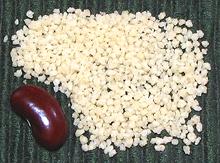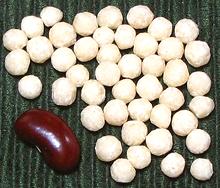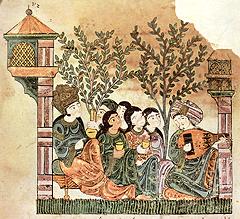
SAFARI
Users
General & History
The Arabic name, itriyah, indicates dried noodles obtained from a merchant. This implies fresh noodles were already well established in home kitchens by the 5th century. Their origin is not known, but the Greeks were apparently rolling out a lasagne-like form a thousand years before, so it can be considered fairly ancient.
Arabic noodles sold today are from bread wheat, rolled and cut into soft fragile strips, so they don't quite qualify as "pasta". They are often sold toasted, a treatment not found elsewhere except in India.
Some think couscous, a form of true pasta, may have been invented in Sardenia and taken from there to North Africa, and eventually to other Arab dominated lands - or it could have been developed in North Africa. The only thing we can have much confidence in is that Sardenia had durum wheat and traded with North Africa. The Arabs introduced dried pasta to Sicily, and it traveled from there to Italy after the Arabs were thrown out by the Norman king Roger I in 1091.
Wheat Noodles
I shop at several large markets serving Near and Middle Eastern communities in Los Angeles. These bread wheat noodles are the only form I've seen that is identified with that region. If any other form was of significant importance, I'm sure it would be sold in these markets. These noodles have remainied pretty much unchanged since around 500 CE.
Arabic Noodles- [166] These noodles, made from bread flour, are very similar in flavor and
texture to similarly made Chinese noodles. They are sweeter in
flavor and much more elastic than durum wheat pasta. Cooking time
about 12 minutes. The photo specimens, probably made in California,
were 10.5 x 0.12 x 0.040 inches. Ingred: wheat flour, salt.
These noodles, made from bread flour, are very similar in flavor and
texture to similarly made Chinese noodles. They are sweeter in
flavor and much more elastic than durum wheat pasta. Cooking time
about 12 minutes. The photo specimens, probably made in California,
were 10.5 x 0.12 x 0.040 inches. Ingred: wheat flour, salt.
Arabic Noodles - Toasted- [167] These noodles, made from bread flour like the regular Arabic noodles,
are then toasted. The flavor is a cross between the regular noodles
and toast. Cooking time is about 12 minutes. The photo specimens,
probably made in California, were 11 x 0.90 x 0.040 inches. Ingred:
wheat flour, salt.
These noodles, made from bread flour like the regular Arabic noodles,
are then toasted. The flavor is a cross between the regular noodles
and toast. Cooking time is about 12 minutes. The photo specimens,
probably made in California, were 11 x 0.90 x 0.040 inches. Ingred:
wheat flour, salt.
|
Couscous
Whether originating from Sardinia or North Africa, couscous, in all its variations, is true pasta, made from durum wheat and dried.
Couscous Moyen- [183] This is the traditional couscous of North Africa. It is cooked by
wrapping it in a cloth and steaming, often over a pot in which an
accompanying stew is cooking. Boxed "couscous" sold in North America
is generally a precooked "quick cooking" version which is quite
inferior to the real thing. The photo specimens are product of
Morocco, random sizes from .02 to .08 inch. Ingred: durum wheat, water.
This is the traditional couscous of North Africa. It is cooked by
wrapping it in a cloth and steaming, often over a pot in which an
accompanying stew is cooking. Boxed "couscous" sold in North America
is generally a precooked "quick cooking" version which is quite
inferior to the real thing. The photo specimens are product of
Morocco, random sizes from .02 to .08 inch. Ingred: durum wheat, water.
Couscous Maftoul- [202] [Palestinian Couscous]
[Palestinian Couscous]
This couscous is popular in the Levant. It is cooked not by steaming
as North African couscous is, but by boiling as Italian pasta would
be. The photo specimens were product of Jordan, beads about 0.150 inch
diameter. Ingred: durum semolina, wheat flour, water, salt.
Details and Cooking.
Couscous Moghrabieh- [203]
This couscous is popular in Lebanon, and properly called Lebanese
couscous. This form is often mistakenly called "Israeli couscous".
Israeli couscous was actually a failed project to make a rice shaped
couscous acceptable to Jewish immigrants from rice eating regions.
Like Maftoul, it is cooked by boiling as Italian pasta would be. The
photo specimens were product of Lebanon, beads about 0.24 inch diameter.
Ingred: durum semolina, salt.
|



